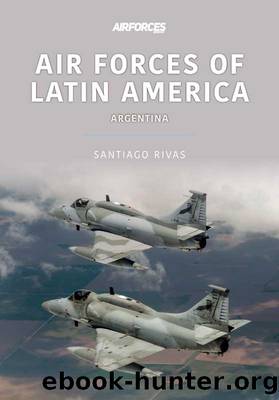Air Forces of Latin America by Santiago Rivas

Author:Santiago Rivas
Language: eng
Format: epub
Publisher: Key Publishing
Published: 2021-05-26T00:00:00+00:00
The T-34C-1 has been the naval aviation basic trainer for more than 40 years. While a modernization programme is in progress, the force also wants to acquire more aircraft from the USA.
When FAdeA announced the IA-100B Malvina programme for a basic trainer, it stated that the type could be used by the navy on ESAN, with 12 aircraft that could be delivered between 2023 and 2025, but currently the force has little interest in the type.
With the retirement of the last Embraer EMB-326 Xavantes in 2007, which operated with 1º Escuadrilla Aeronaval de Ataque, naval aviation lost its advanced training capability after no replacement was purchased. From the late 1980s, interest in the IA-63 Pampa was shown and an embarked version was evaluated. When Pampa II was launched it was stated by the Argentine government that eight would be delivered to the navy, but this never happened. While naval aviation still has some interest in the Pampa, once again no funding has been allocated for it.
Currently, while naval aviation is preparing crews to fly the Super Ãtendards, new pilots are being trained with the Pampa IIIs of the Argentine Air Force in Tandil.
Escuadrilla Aeronaval de Vigilancia MarÃtima (EA6V) was formed on 1 April 1996 from a cadre of Escuadrilla Aeronaval de Reconocimiento, at Base Aeronaval Almirante Zar (BAAZ) in Trelew, Chubut province. In 2008, it moved to Punta Indio. Originally it was part of Escuadra Aeronaval No 6, later it was moved to No 4, but now it is part of No 1.
In 1992, naval aviation was looking for a light maritime surveillance aircraft and investigated the purchase of a batch of B-200T Super King Airs, but in 1994 it was decided to locally modify the four B-200s of Escuadrilla Aeronaval de Reconocimiento for this mission. The work was carried out by Arsenal Aeronaval No 1 at Punta Indio under the name of Project Cormorán. Work to modify the first aircraft began in 1996 and ended the following year, with the last example delivered in 2001. The aircraft received a Bendix RDR 1500 surveillance radar, new bubble windows in the rear fuselage, tactical computer, new UHF, HF and VHF radios, an Agiflite camera connected to the GPS, and capacity to drop smoke markers, flares and a life raft, four-blade propellers, new main landing gear doors and other improvements. The last aircraft also received additional fuel tanks behind the engine nacelles.
The Agrupación Aeronaval Aerofotográfica is also equipped with Beech B-200 Super King Airs, one for general purposes and the other two for photo surveys, equipped with an opening in the belly for the use of vertical cameras.
Download
This site does not store any files on its server. We only index and link to content provided by other sites. Please contact the content providers to delete copyright contents if any and email us, we'll remove relevant links or contents immediately.
| Argentina | Bolivia |
| Brazil | Chile |
| Colombia | Ecuador |
| Guyana | Paraguay |
| Peru | Suriname |
| Uruguay | Venezuela |
Cat's cradle by Kurt Vonnegut(15155)
Pimp by Iceberg Slim(14322)
4 3 2 1: A Novel by Paul Auster(12263)
Underground: A Human History of the Worlds Beneath Our Feet by Will Hunt(11997)
The Radium Girls by Kate Moore(11900)
Wiseguy by Nicholas Pileggi(5649)
Perfect Rhythm by Jae(5306)
American History Stories, Volume III (Yesterday's Classics) by Pratt Mara L(5239)
The Fire Next Time by James Baldwin(5224)
Paper Towns by Green John(5065)
Pale Blue Dot by Carl Sagan(4886)
A Higher Loyalty: Truth, Lies, and Leadership by James Comey(4822)
The Mayflower and the Pilgrims' New World by Nathaniel Philbrick(4403)
The Doomsday Machine by Daniel Ellsberg(4397)
Killers of the Flower Moon: The Osage Murders and the Birth of the FBI by David Grann(4368)
The Sympathizer by Viet Thanh Nguyen(4287)
Too Much and Not the Mood by Durga Chew-Bose(4256)
The Borden Murders by Sarah Miller(4216)
Sticky Fingers by Joe Hagan(4086)
